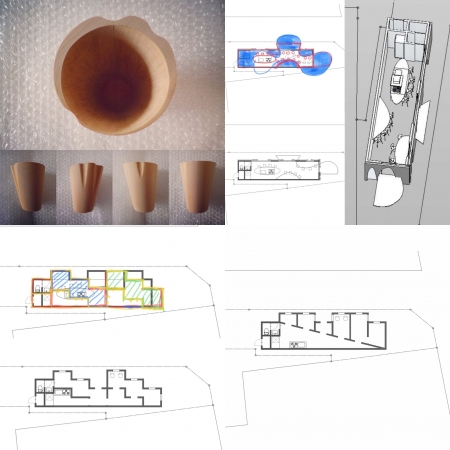不完全性がつなぐ気分と物
以前に考えたフリーカップでは気分という物を形にできたとするならば、今度はそのフリーカップが建築だとして考えてみる。
そうすると違いはがりに目がいく。フリーカップは簡単に動き、回転できるが、建築は動かない。フリーカップは人が手で操ることができるが、建築は人が内部に入り込み使う。やはり、スケールの違いが全く違う物を生み出しているように思える。
ただ、手だけにせよ、人が何かのアクティビティを起こす余地があり、そのアクティビティには人の感情を絡めることができそうなのはフリーカップも建築も同じである。
例えば、人がいなくてもフリーカップも建築も物として実在できるが、あくまでも人が使う物だから、人がいなければ不完全な物である。『茶の本』で岡倉天心は茶室の不完全性を説いていたが、それと同じで人がいてフリーカップも建築も完全な物になる。
そう考えると、人のアクティビティは不完全な物を完全にするために発生するともいえ、人が完全な物にするための余地を残した不完全性を纏うことが気分と物をつなぐことになるともいえる。
"Mood and things that imperfections connect"
If the free cup you thought about before could give shape to your mood, then think of it as architecture.
Then you will notice the difference. Free cups move and rotate easily, but architecture doesn't. Free cups can be manipulated by humans, but architecture is used by people inside. After all, it seems that the difference in scale produces something completely different.
However, it is the same in free cups and architecture that there is room for a person to perform some activity, even if only by hand, and that activity can involve human emotions.
For example, free cups and architecture can actually exist as objects without people, but since they are used by people, they are incomplete without people. In "The Book of Tea", Tenshin Okakura explained the imperfections of the tea room, but in the same way, there are people and the free cup and architecture are perfect.
Given that, even though human activity occurs to perfect imperfections, wearing imperfections that leaves room for humans to perfect is what connects mood and things. It can be said that it becomes.


